By: Sandy Takahashi, Hāmākua Jodo Mission Member
The First Buddhist Temple in Hawai‘i
In 1894, Reverend Gakuo Okabe was sent to O‘ahu, Hawai‘i as an officially selected Jodo Shu priest.  Approximately two months later, Okabe left for Maui and then headed to Hawai‘i Island. After arriving in the County of Hāmākua, Reverend Okabe garnered a strong following among the Japanese immigrants living on the plantations who felt he was a sincere and honorable priest. Recognizing this, they rented him a house and placed a sign in front that read “Sacred Altar of Amida Buddha from Japan.”
Approximately two months later, Okabe left for Maui and then headed to Hawai‘i Island. After arriving in the County of Hāmākua, Reverend Okabe garnered a strong following among the Japanese immigrants living on the plantations who felt he was a sincere and honorable priest. Recognizing this, they rented him a house and placed a sign in front that read “Sacred Altar of Amida Buddha from Japan.”
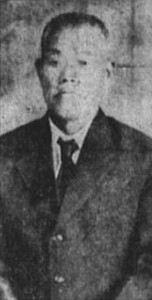
Tanikichi Fujitani
Reverend Okabe worked tirelessly to spread his mission work of the teachings of Buddhism by visiting many locations, giving sermons and performing special memorial services for unknown deceased people, carrying an Amida Buddha statue on his back wherever he went. After some time, the Japanese community felt it was time to have a home temple built with Reverend Okabe as their sensei (“teacher” is its proper translation; however, this term is also used to address ministers, as well as doctors and lawyers).
Hisashi Shimamura, the Imperial Consulate General of Japan to Hawai‘i, soon paid a visit. Members of the Japanese immigrant community mentioned the idea of building a home temple in Hāmākua. Consulate General Shimamura was so pleased with the idea that he pledged $300 to begin construction.
Led by Reverend Okabe, the Japanese immigrant community worked extra hard to raise additional funds. This was a seemingly impossible task, but Reverend Okabe and one of the founding members, Tanikichi Fujitani persisted by going house to house on foot seeking donations within the plantation camps. They often subsisted on bananas on their journeys, all to make the immigrants’ dream of having a temple a reality.
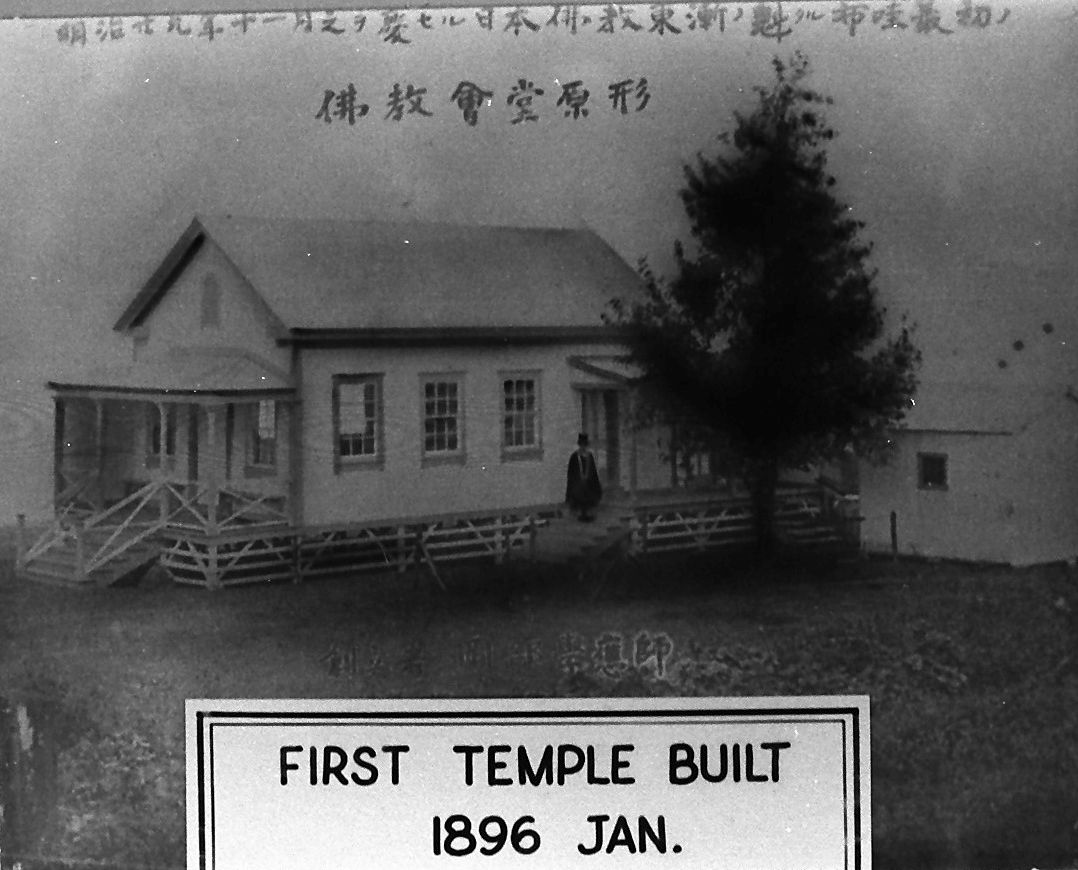
As a result of their effort, in 1896 the first sanctioned Buddhist temple in Hawai’i named the “Hāmākua Bukkyo Kaido” (which would later be renamed as the Hāmākua Jodo Mission) was built in the current location in Pa‘auhau Mauka, the geographic center of the five sugar plantations. The total cost to build the temple was $3,000.
In 1918, under the direction of Reverend Ryoyu Yoshida, the fourth minister to serve at Hāmākua Jodo Mission, a new temple (“konpondo”) was built next to the original one. The design and construction was executed by Umekichi Tanaka, a Japanese immigrant who was trained as a miya daiku, a carpenter who only builds shrines and temples. Members and volunteers from the community helped Mr. Tanaka build the current konpondo on the weekends and after hours following long, physical work in the sugar fields. Kiichiro Okamoto served as a construction superintendent on the project. The structure, built entirely without nails, employed the traditional systems of wood joinery known as sashimono and measurement called shakkanho.
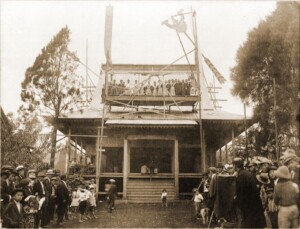
Konpondo Dedication, 1918.
After receiving permission from the Pa‘auhau Sugar Plantation Manager, several koa trees were removed from the forest behind the temple. Mr. Tanaka, along with Eizuchi Higaki and an unknown laborer, painstakingly carved an intricate altar and transoms for the temple, highlighting their skilled craftsmanship.
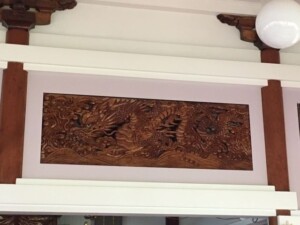
Koa Wood Transoms
A dedication ceremony was held after the completion of the temple. The original temple was then converted into a small kitchen and dining hall, which remains on the property to this day.
A cemetery located behind the temple is one of the oldest on Hawai‘i Island. Before Hāmākua Jodo Mission was established, part of the land was used as a burial ground for immigrant workers, many of whom had no family in Hawai‘i. This resulted in a number of unidentified graves marked only with a large rock. Anecdotal stories note that there was a neighboring hospital that had many patients who passed away during a cholera outbreak. These patients of many ethnicities were buried where the current cemetery is located.
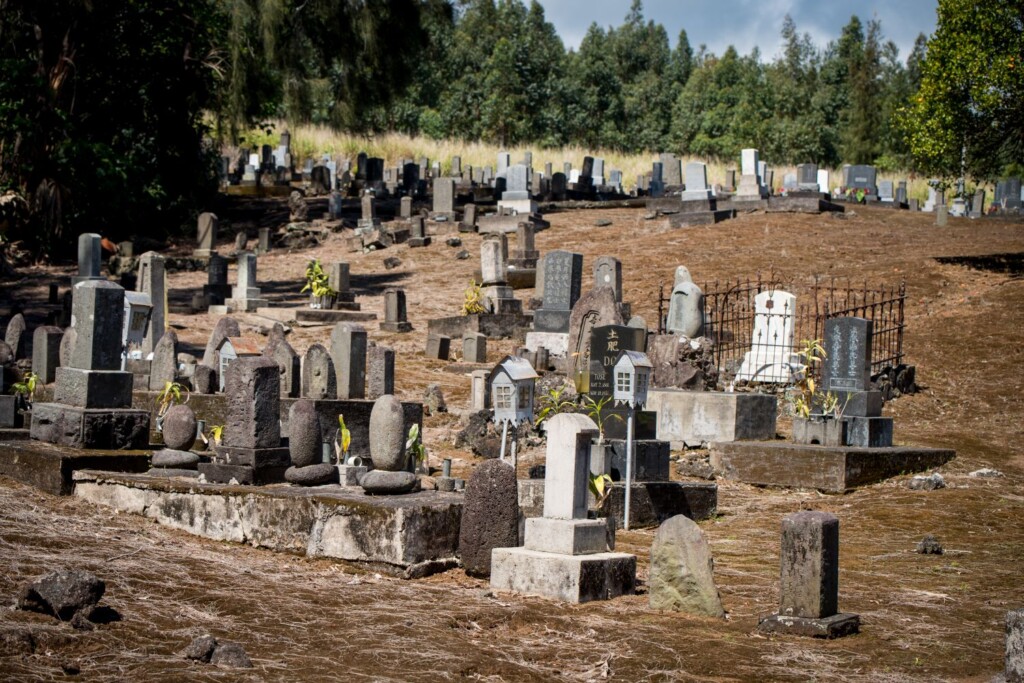
Hāmākua Jodo Mission Cemetery. Copyright Sarah Anderson, used with permission.
Most notably, Hāmākua Jodo Mission’s cemetery is also the final resting place of Katsu Goto, a staunch leader of the Japanese community who lost his life fighting for the rights of immigrant laborers. Many visitors often come to the temple in search of his gravesite, which symbolizes an important part of Hawai‘i’s history.
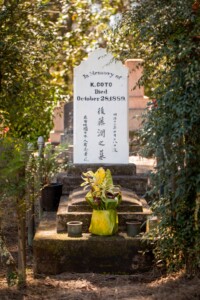
Katsu Goto Gravesite (Copyright Sarah Anderson, used with permission)
Hāmākua Jodo Mission played an important role for the Issei (people who were born in Japan and were the first generation of Japanese to immigrate) on the Hāmākua Coast and at one point boasted over 600 members.
Unfortunately, like many Buddhist temples in Hawai‘i, membership has been dwindling over the years. A lot of the members have passed on and the remaining active handful left are in their mid-80’s and 90’s.
Many children and grandchildren of deceased members either have moved away, have different religious beliefs or know very little about the temple. As a result, the temple has operated at a standstill for many years except for the yearly bon dance. The temple currently faces many challenges including a shortage of funds and reliance on an aging membership to upkeep the property. Today, the temple runs solely on donations, leaving many worried about its future and who will take over once the elders are gone.
Presently, some of the younger members are taking initiative to turn things around for the temple and quell people’s worries about the future. Long term goals to recruit new members, volunteers and donors are underway, along with the creation of a multi-year vision plan to help reinvigorate interest in the temple. Educational events, lectures, classes and active fundraising are being explored. Inspiring members of the community and the younger generation to become involved and providing education on the temple’s historical value have been initiated via two websites including History Pin and exhibits at the newly opened Honoka‘a Heritage Center. Media coverage contributes to these outreach efforts. Hāmākua Jodo Mission was recently featured on the popular local television show “Seniors Living in Paradise” and in print publications such as The Hawai‘i Herald, Ke Ola Magazine, Hamakua Times and the Japanese Chamber of Commerce & Industry of Hawai‘i newsletter. View media links here.
Change has proven to be a challenge, but the ganbare (“persevere, go for it!”) spirit that Reverend Okabe and the Japanese immigrants held still lives on among those who are working hard to ensure Hāmākua Jodo Mission prospers into the future.
Remembrances of Mission Members
Several Hāmākua Jodo Mission members* shared their thoughts about the temple and what it means to them. An overwhelming sense of pride over multiple generations is the common denominator.
“I have a great sense of pride and affection for Hāmākua Jodo Mission. It is a temple that reflects the dedication and ingenuity of our ancestors. The temple was built by volunteers using their bare hands with limited funds, yet managed to accomplish a building that is an architectural masterpiece.”
~ Masayoshi “Masa” Nishimori, 3rd Generation (Sansei) Member and Kyodan President
“My great-grandfather and great-grandmother, Tsunematsu and Tsuta Takahashi, were two of the earliest members of the Hāmākua Jodo Mission in the early 1900s. I take great pride knowing that they were an integral part of the Pa‘auhau Community and laid the foundation for generations of my family. The temple and grounds have such a rich history and peace about them and I hope they are around for generations more to experience.”
~ Jan Kamiya, 4th Generation (“Yonsei”) Member
“I started attending Hāmākua Jodo Mission at a very young age since my parents were devoted members who shared a strong faith in the Jodo Shu teachings. They were heavily involved in activities and taught my siblings and I the doctrines and traditions of Buddhism, and the importance of honoring our ancestors. My father used to volunteer at the temple after he was done working at the plantation for the day. He never mentioned what he did at the temple, but many years later I found out that one of the many projects he worked on was the carved koa wood transoms that adorn the walls inside the temple. I felt so proud of this, and it made me even more interested in learning about Hāmākua Jodo Mission and having our history preserved.”
~ George Higaki, 3rd Generation Member (Sansei) and former Board Director
“The Okamoto family has been affiliated with Hāmākua Jodo Mission since its early years. Our patriarch Kiichiro Okamoto (1878-1958), emigrated from Kumamoto, Japan in 1907, and was a member until his passage. One hundred fourteen years later, direct descendants continue Kiichiro’s legacy.”
~ Eugene Y. Okamoto, 3rd Generation (Sansei) Member
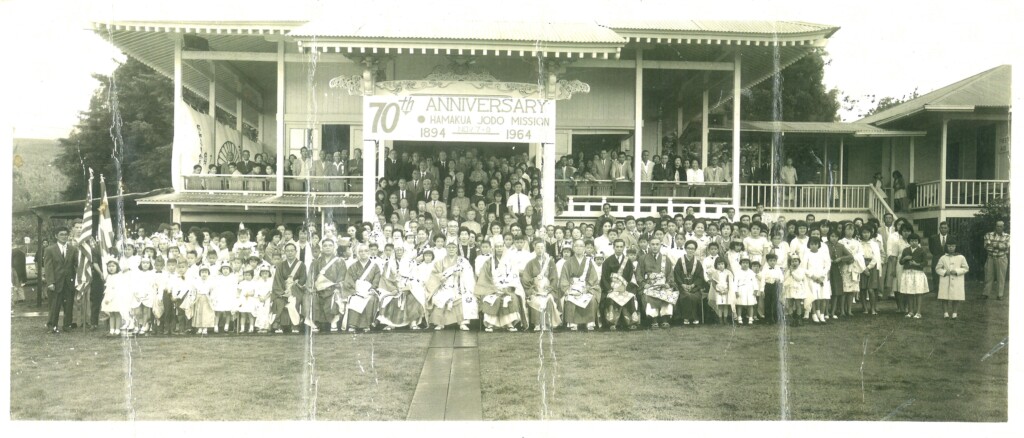
Hamakua Jodo Mission, 70th Anniversary Celebration, 1964.
In 2017, Historic Hawai‘i Foundation awarded the Hāmākua Jodo Mission a grant through the Freeman Foundation to replace the temple’s weathered roofing. The roof replacement project was completed in October of 2018. Sensei Wajira Wansa remarked, “The project was very challenging. The contractor had to navigate inclement weather conditions as well as find a large enough lift locally. We are happy with the workmanship. The appearance of the temple looks like its original days with the new roof.”
To learn more about Hāmākua Jodo Mission and how you can help (volunteer, become a new member, donate), visit our websites by clicking on the links below or scanning the QR codes:
http://Bit.ly/HamakuaJodoMission

*Note: Mr. Nishimori and Mr. Higaki both had fathers who were Issei, the 1st generation of Japanese who immigrated to Hawai‘i. Mr. Nishimori and Mr. Higaki’s mothers were considered Nisei, the 2nd generation since both women were born in Hawai‘i. Descendants often ask whether they would they be considered Nisei or Sansei (3rd generation) in cases like these where one parent was Issei and the other was Nisei. According to Wikipedia, children of at least one Nisei parent are to be considered Sansei.


